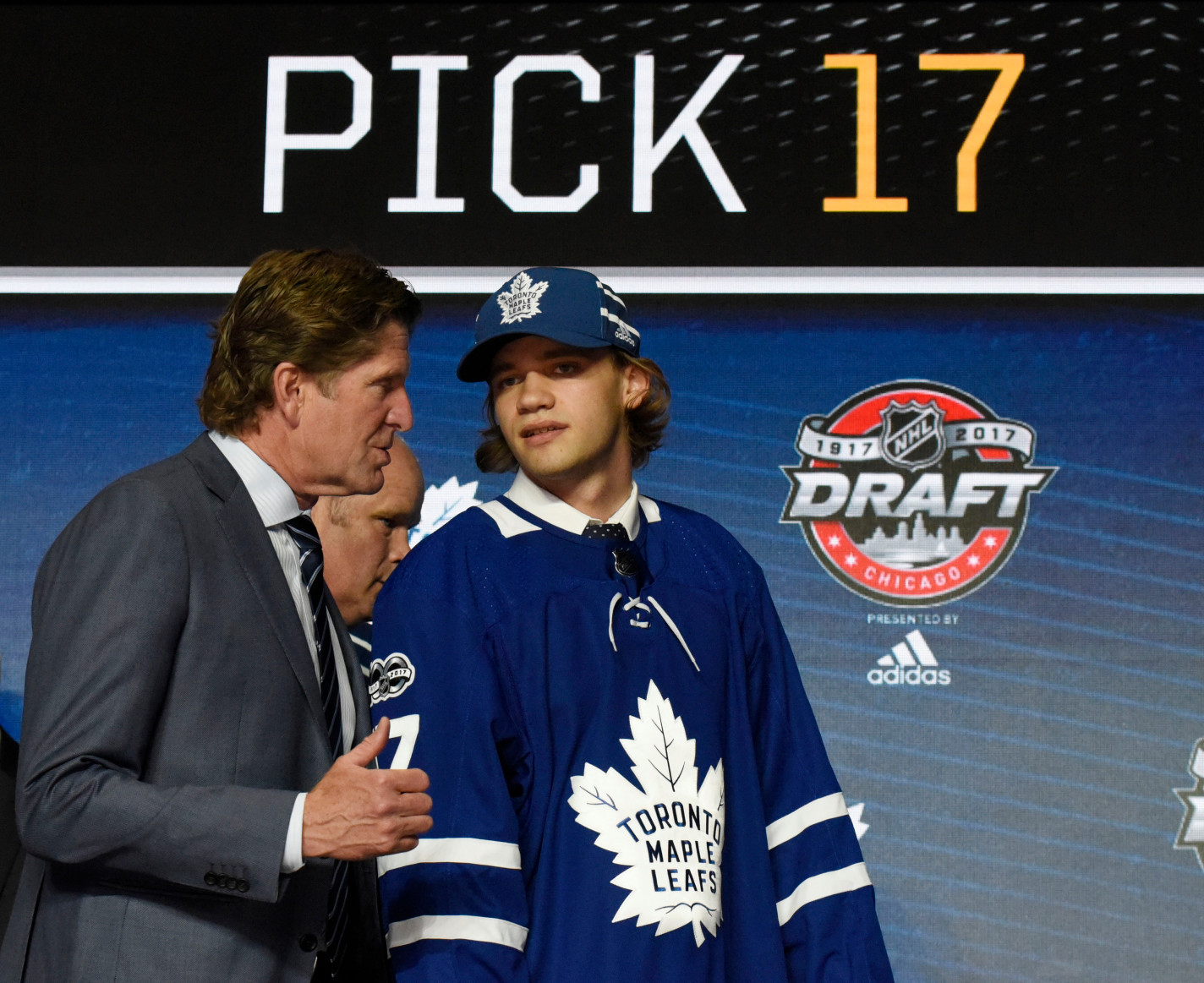The Toronto Maple Leafs have signed 2017 17th overall pick Timothy Liljegren to a three-year entry-level contract, the club announced on Wednesday.
#Leafs sign Timothly Liljegren to three year entry level deal. $925,000 (incl $92,500 signing bonus) and Salary A bonuses to $400,000 max.
— Kevin McGran (@kevin_mcgran) July 12, 2017
The Leafs, as confirmed by Lou Lamoriello today, are looking at two options with Liljegren’s destination for the 2017-18 season — either with the Marlies in the AHL or in the SHL with Rogle BK, where he is under contract for one more year. It’s possible Liljegren could do a bit of both, as William Nylander did in his draft year when he started with Modo, went to the World Juniors, and finished in Toronto with the Marlies for the second half of the regular season plus playoffs (bouncing him between teams after he never really settled in one spot on one team last season is the question mark with this approach).
There isn’t necessarily a wrong answer here. In the SHL, Liljegren would be on the big ice surface but competing at a high level against men, which he hasn’t done yet for a full season (just 19 games in both 2015-16 and 2016-17). In Toronto, he would be developing on the North American rink under the Marlies/Leafs coaching staff, development staff and sports science staff in second-to-none facilities while adjusting to the off-ice lifestyle that comes with being a high-profile Leafs player in Toronto.
While there were more pros listed in the Marlies column than the SHL column in the paragraph above, the Leafs will have to balance those benefits against the fact that the AHL is a tough league for an 18-year-old to play in (physically demanding, with a tough schedule), especially considering Liljegren didn’t play a full 17-year-old season overseas due to mono. The big club’s current weakness on the backend, combined with the usual pressures associated with a first-round draft choice of the Leafs, means that the fan base and media will be quick to ask the question about when Liljegren will be ready for NHL duty and will be monitoring his progress very closely. While current Leafs management has shown that they are very unlikely to rush a prospect, there is a pressure that comes with playing in the Toronto spotlight for Liljegren himself.
There are a number of potential benefits to bringing Liljegren under the organization’s full control in Toronto, but rushing him to the Marlies could also be seen an unnecessary risk or distraction when he could instead develop his game at home against men in the SHL – where the hockey is less physical and the injury risk is lower – after a 2016-17 season in which he didn’t benefit from a full, uninterrupted year of development and fell in the draft order accordingly.
Further Reading:
- Timothy Liljegren scouting analysis, video
- Liljegren scores in scrimmage on final day of development camp
- 2017 Draft: Trends, analysis and thoughts on the Toronto Maple Leafs’ strategy



![Sheldon Keefe on the Maple Leafs’ struggling power play: “[We’ve scored] one out of 11 high-danger chances in tight to the net… We have been in those spots and haven’t converted” Sheldon Keefe, playoff press conference](https://mapleleafshotstove.com/wp-content/uploads/2024/04/keefe-pc-game-3-218x150.jpg)

![Jim Montgomery Post Game, Bruins 4 vs. Leafs 2: “[Marchand] still manages to get under people’s skin, yet he doesn’t cross the line” Jim Montgomery, Boston Bruins post game](https://mapleleafshotstove.com/wp-content/uploads/2024/04/jim-monty-pg-to-218x150.jpg)
























![Sheldon Keefe on the Maple Leafs’ struggling power play: “[We’ve scored] one out of 11 high-danger chances in tight to the net… We have been in those spots and haven’t converted” Sheldon Keefe, playoff press conference](https://mapleleafshotstove.com/wp-content/uploads/2024/04/keefe-pc-game-3-100x70.jpg)



![Jim Montgomery Post Game, Bruins 4 vs. Leafs 2: “[Marchand] still manages to get under people’s skin, yet he doesn’t cross the line” Jim Montgomery, Boston Bruins post game](https://mapleleafshotstove.com/wp-content/uploads/2024/04/jim-monty-pg-to-100x70.jpg)
